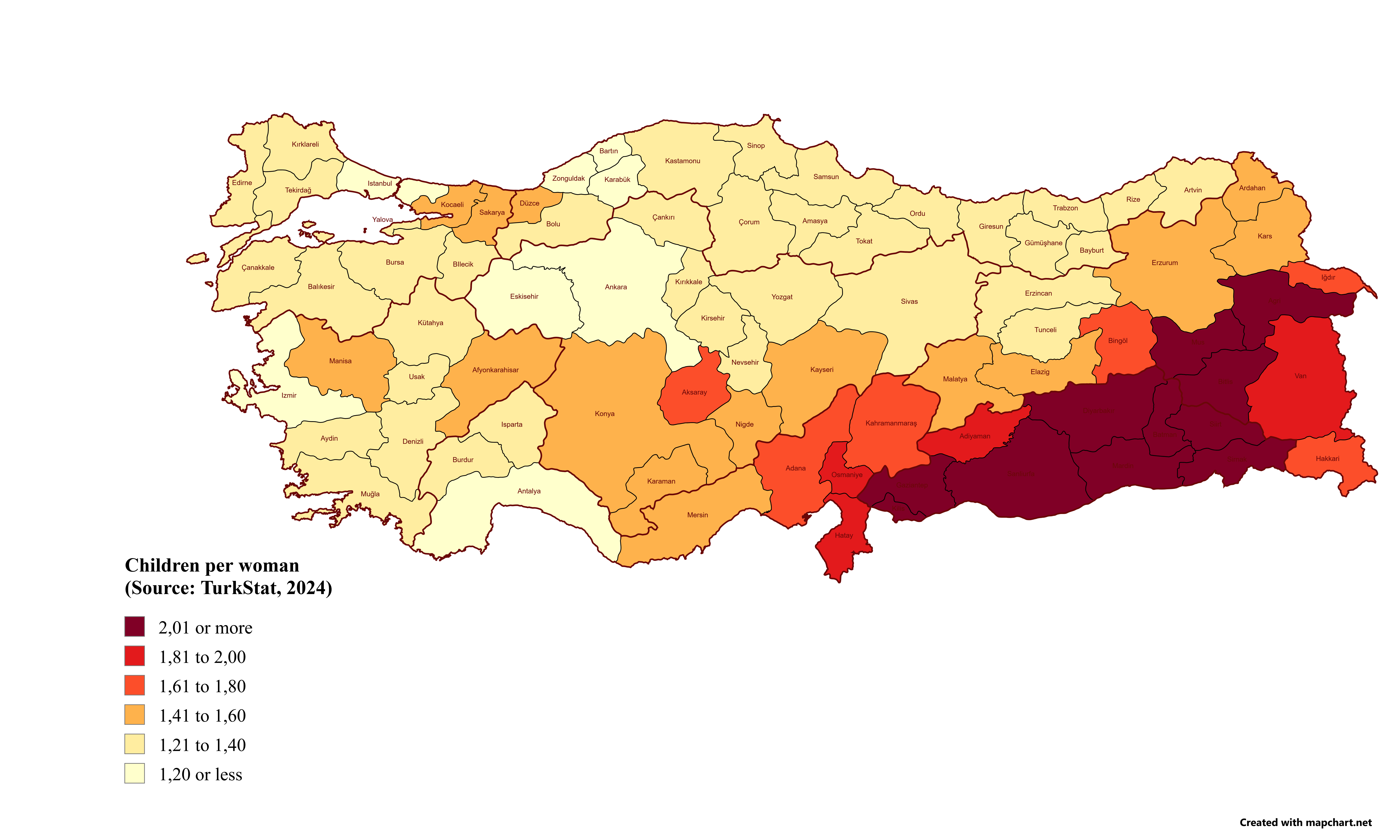Children per Woman in Turkey by Province Map


Alex Cartwright
Senior Cartographer & GIS Specialist
Alex Cartwright is a renowned cartographer and geographic information systems specialist with over 15 years of experience in spatial analysis and data...
Geographic Analysis
What This Map Shows
The "Children per Woman in Turkey by Province Map" provides a visual representation of fertility rates across Turkey's provinces. This map highlights the average number of children born to a woman throughout her lifetime, a key indicator of demographic trends and societal norms. Understanding these rates is crucial as they reflect cultural, economic, and social factors influencing family size in different regions of the country.
Deep Dive into Fertility Rates in Turkey
Fertility rates are more than just numbers; they encapsulate a society's values, economic conditions, and health care access. In Turkey, the total fertility rate (TFR) has undergone significant changes over the decades. According to recent statistics, the overall TFR in Turkey has dropped from about 4.3 children per woman in the 1980s to around 2.1 in the early 2020s. This decline can be attributed to various factors including urbanization, increased access to education, and women's participation in the workforce.
Interestingly, the map reveals stark regional variations in fertility rates. Provinces in the eastern part of Turkey generally exhibit higher TFRs, often exceeding 3 children per woman. In contrast, western provinces such as Istanbul and Izmir show lower rates, often close to or below the replacement level of 2.1. This discrepancy raises questions about the underlying causes—what influences family planning decisions in these regions?
Socioeconomic factors play a significant role. In more urbanized and economically developed provinces, couples tend to prioritize careers and education over larger families. For instance, Istanbul, as a major urban center, reflects modern lifestyles where financial stability and personal aspirations often lead to delayed childbirth and smaller family sizes. On the other hand, rural areas in provinces like Ağrı or Van still adhere to more traditional values, where larger families are often viewed as beneficial for labor support and security.
Additionally, access to healthcare and family planning services dramatically impacts fertility rates. Provinces with better healthcare infrastructure and educational resources tend to have lower fertility rates. Women in these regions are more likely to receive education about reproductive health, leading to informed family planning choices. This creates a cycle where lower fertility rates contribute to increased educational attainment for women, further perpetuating the trend.
Regional Analysis
Analyzing the regional differences in Turkey's fertility rates, we can categorize provinces into three main groups.
1. **High Fertility Regions**: Eastern provinces such as Şırnak, Mardin, and Hakkari often report TFRs above 3. These areas are characterized by conservative cultural norms and economic conditions that favor larger families.
2. **Moderate Fertility Regions**: Provinces like Kayseri and Konya in Central Anatolia show more moderate rates, typically around 2.5. Here, we see a blend of traditional values and the influences of urbanization beginning to take root.
3. **Low Fertility Regions**: Western provinces like Istanbul, Antalya, and İzmir exhibit TFRs below 2.1. The shift toward smaller families is evident in these urbanized areas, where lifestyle changes and economic considerations heavily sway family planning.
Interestingly, Turkey's capital, Ankara, sits at an average rate close to the national figure, reflecting its status as a melting pot of various cultures and socioeconomic backgrounds.
Significance and Impact
Understanding fertility rates is crucial for policymakers and sociologists alike. These numbers serve as indicators of population growth, economic development, and social change. For instance, a declining fertility rate can signal a shift towards an aging population, which may lead to challenges such as labor shortages and increased healthcare costs for the elderly.
Moreover, the implications of these trends can affect national policies on education, health care, and economic incentives. Addressing the needs of regions with high fertility rates may require targeted educational initiatives and healthcare improvements to promote family planning. Conversely, areas experiencing low fertility may need to focus on attracting families through incentives that encourage population growth.
What's fascinating is how these trends can also reflect broader global patterns. As countries modernize, similar trends in fertility are observed worldwide, emphasizing a universal shift in reproductive behavior. However, Turkey's unique cultural and historical context makes it a compelling case study of how various factors converge to shape population dynamics.
In conclusion, the "Children per Woman in Turkey by Province Map" is not just a statistical representation; it’s a window into the societal values and economic conditions across Turkey. By understanding these fertility trends, we can better appreciate the diverse fabric of Turkish society and anticipate future demographic shifts.
Visualization Details
- Published
- October 30, 2025
- Views
- 8
Comments
Loading comments...